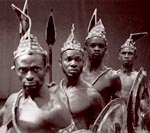|
Wolfram |
| Search |
I was lucky enough to have watched a performance called Kusum Africa at the Zellerbach Auditorium in Berkeley on March 2nd, 2002. It was a vibrant red and yellow tapestry of movement created by four African choreographers and their respective companies: Francis Nii Yartey of the National Dance Company of Ghana, Kemoko Sano of Ballet Merveilles De Guinea, CK Ladzekpo of African Music and Dance Ensemble, and Malonga Casquelourd of Fua Dia Congo.
The curtain rose to sounds of a distant drum. A female voice chanted an African call followed by a group of voices who echoed the sub-sahara cry. "Kaxoxowo nu wo gbea yeyeawo do," which means, "By the example of old ropes we learn to weave new ones." And even though I didn't understand the language, specifically, I understood the emotion behind the language -- because art is universal.
And this art clearly demonstrated a deep pride in the rich African heritage. It restated a fundamental unity of people. It showed me again how dance is absolutely woven into the African personality. Hidden in the highly skilled and subtile movements, I could make out the origins of such dance styles as haitian voodoo dances, Calipso of Trinadad, and the Brazilian Samba. I even saw origins of break dancing, hip hop and MTV.
At one moment, a group of woman each took turn in center stage. These were big woman, tall and full, and they moved with such power and pride in a competitive flirtatious fertility display. A group of men rode long and large phallic drums, and pounded on them at fantastic speeds. They surrounded the women as the intensity grew to an absolutly frantic pace, each tempo faster then the next, and each dancer bound in rhythm.
 Faster and faster, louder and louder, the men started dancing too. Dancer after dancer tumbled across the stage, higher, faster, quicker then the last -- until the spectacle hinged on the very edge of possibility. The dancers were incredibly beautiful and good looking. They succeeded in taking me away, into an interactive participation -- I wanted to jump up and join them. Watching the show, I felt that I had been transported into a village in Ghana, and was privy to a sacred traditional celebration. The persistance of the drum music took on a religious demention.
Faster and faster, louder and louder, the men started dancing too. Dancer after dancer tumbled across the stage, higher, faster, quicker then the last -- until the spectacle hinged on the very edge of possibility. The dancers were incredibly beautiful and good looking. They succeeded in taking me away, into an interactive participation -- I wanted to jump up and join them. Watching the show, I felt that I had been transported into a village in Ghana, and was privy to a sacred traditional celebration. The persistance of the drum music took on a religious demention.
Between the divertisment, a vague story was told. There was a king, a princess, the people and a hero. The king battled the hero and tied him up. The king went back to his throne. There he watched hours of dance. By the end of the night, the hero battled the king, took the princess and the people cheered. The king, defeated, took his life.
Colorful costumes helped the illusion along, red dyed straw fringe, yellow peaked hats, and brown dresses made of golden printed fabric. Bells and beads, head dress and feathers -- one characters costume was entirely made of long fringe. When he tumbled around the stage, he looked like a giant Koosh ball.
At times the lighting muted the colors of the costumes. The primary colors in the lighting, red, green, blue; unmixed and random, worked against the production. Shadows hid the king on the throne while the dancers performed divertisment below, for instance, and a little light on him would not have distracted from the excitement he was watching. If he was to be hidden from the audience with darkness, I wondered, then why keep him on stage at all?
All in all, the show lasted 2 hours and 45 minutes including a fifteen minute intermission. The first act was the longest, a full hour and 45 minutes. But there were so many dancers and so many drummers and musicians, each one had their moment of fame, and by the end of the night the audience was whooping, yapping and applauding. So was I. Kusum means culture or tradition in the language of Ga, as spoken by the Ga people of Accra Ghana. Kusum Africa had plenty of that.
Learn more about African Music and Dance